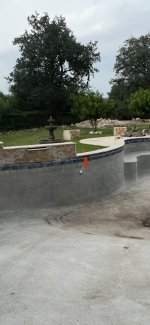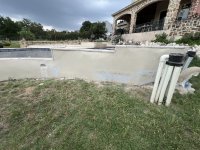I’m trying to help an older disabled vet who had this inground pool put in maybe 2-3 years ago now. Here’s the story for context as I’ve been told it. The pool builder offered a “lifetime” warranty but of course now is no longer in business. After them trying to get the pool builder to come out and fix the leak without success they resorted to just draining the pool since it was leaking badly over several inches a day.
The pool has been empty for the most part aside from rain water for the entire time.
They’ve had several companies come out and have gotten quotes from $1600 to $10,000 for leak detection and repair costs, but no company has actually brought out any leak detection equipment.
Since there is no water in the pool I can’t do the dye leak test and from looking at it visually it looks like the damage to the outer pool is directly in line with the drain pipe. I tried to talk the owner into plugging the drain pipe but he didn’t want to pay to put water in the pool and not know if that was causing the issue, even though it seems like the most likely source. He did attempt to plug the drain at one point but said that the plug I gave him didn’t fit.
It’s a 1 1/2 inch plug, I didn’t check it myself because there is usually water in the bottom that he has to pump out so I can open the cover and he seems adamant that he just wants me to open up the wall. So I drilled with an angle grinder into the outer wall where there appears to be water damage but slightly to the left of where I thought the vertical drain pipes may be just so I could be sure I wouldn’t accidentally cut into one. Well since doing this, I realize that I must still be in a structural portion of the wall because while I did hit rebar, I don’t think I came down far enough and maybe too far to the left to actually find a pipe.
I started with the drain line area because it seemed to make sense to me logically due to where the owner said the point the water was draining to and figured if the waterfall fountains were off and the leak was likely not coming from them then perhaps the drain line was broken just above where the water would stop leaking. I know water takes a path of these resistance.I’m honestly baffled that water was seeping through this concrete wall because it is just absolutely solid.
I mentioned to the owner that I would come back and I thought the better option is to start at the bottom of the wall near where the pipes actually go up into the wall and where the most damage is, saw some of that out and then switch to a hammer drill w chisel but I wanted to get someones perspective on this who actually has experience on what I should do because I don’t know much of anything about how the plumbing works when encased in concrete.
On one picture I marked on the inside of the pool with a small red line about where I cut into the wall so you have a point of reference. I also circled in red area I think I should move to to cut instead.
The owner decided to take a chisel to the area. I had cut out so that’s why you see a hole there in the cut area but he said he just continued to hit concrete.
The pool has been empty for the most part aside from rain water for the entire time.
They’ve had several companies come out and have gotten quotes from $1600 to $10,000 for leak detection and repair costs, but no company has actually brought out any leak detection equipment.
Since there is no water in the pool I can’t do the dye leak test and from looking at it visually it looks like the damage to the outer pool is directly in line with the drain pipe. I tried to talk the owner into plugging the drain pipe but he didn’t want to pay to put water in the pool and not know if that was causing the issue, even though it seems like the most likely source. He did attempt to plug the drain at one point but said that the plug I gave him didn’t fit.
It’s a 1 1/2 inch plug, I didn’t check it myself because there is usually water in the bottom that he has to pump out so I can open the cover and he seems adamant that he just wants me to open up the wall. So I drilled with an angle grinder into the outer wall where there appears to be water damage but slightly to the left of where I thought the vertical drain pipes may be just so I could be sure I wouldn’t accidentally cut into one. Well since doing this, I realize that I must still be in a structural portion of the wall because while I did hit rebar, I don’t think I came down far enough and maybe too far to the left to actually find a pipe.
I started with the drain line area because it seemed to make sense to me logically due to where the owner said the point the water was draining to and figured if the waterfall fountains were off and the leak was likely not coming from them then perhaps the drain line was broken just above where the water would stop leaking. I know water takes a path of these resistance.I’m honestly baffled that water was seeping through this concrete wall because it is just absolutely solid.
I mentioned to the owner that I would come back and I thought the better option is to start at the bottom of the wall near where the pipes actually go up into the wall and where the most damage is, saw some of that out and then switch to a hammer drill w chisel but I wanted to get someones perspective on this who actually has experience on what I should do because I don’t know much of anything about how the plumbing works when encased in concrete.
On one picture I marked on the inside of the pool with a small red line about where I cut into the wall so you have a point of reference. I also circled in red area I think I should move to to cut instead.
The owner decided to take a chisel to the area. I had cut out so that’s why you see a hole there in the cut area but he said he just continued to hit concrete.
Attachments
-
 IMG_8087.jpeg155.8 KB · Views: 32
IMG_8087.jpeg155.8 KB · Views: 32 -
 IMG_8071.jpeg842.3 KB · Views: 29
IMG_8071.jpeg842.3 KB · Views: 29 -
 IMG_8075.jpeg677.5 KB · Views: 27
IMG_8075.jpeg677.5 KB · Views: 27 -
 IMG_8076.jpeg594.3 KB · Views: 24
IMG_8076.jpeg594.3 KB · Views: 24 -
 IMG_8077.jpeg497.5 KB · Views: 25
IMG_8077.jpeg497.5 KB · Views: 25 -
 IMG_8072.jpeg667.6 KB · Views: 26
IMG_8072.jpeg667.6 KB · Views: 26 -
 IMG_8073.jpeg806.1 KB · Views: 25
IMG_8073.jpeg806.1 KB · Views: 25 -
 IMG_8076.jpeg594.3 KB · Views: 27
IMG_8076.jpeg594.3 KB · Views: 27 -
 IMG_8078.jpeg446.6 KB · Views: 30
IMG_8078.jpeg446.6 KB · Views: 30
Last edited:






